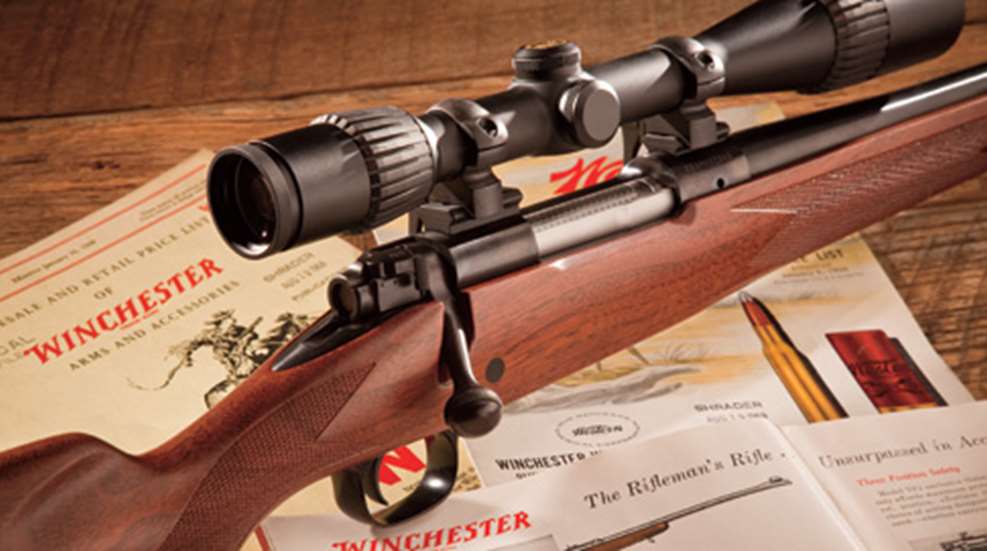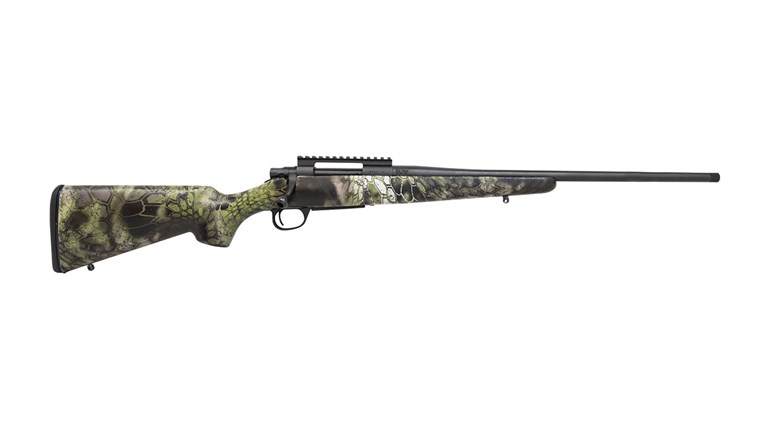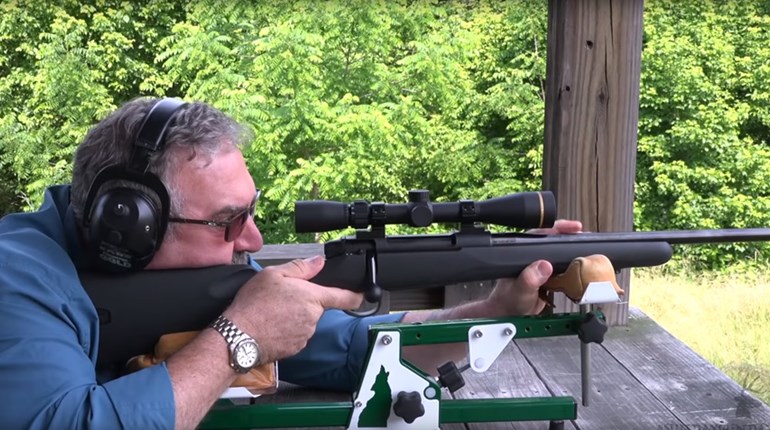
When the Winchester Model 70 appeared in 1936, some theories on rifle accuracy were different from those held today. Back then many people believed that the barrel benefited not only from firm contact with the stock, but needed to be “tied” to the fore-end. Thus, the fore-end screw on what is now known as the “pre-’64” Model 70 came into existence.
Today screwing the fore-end to the barrel is considered unnecessary and is unusual, especially with something as fickle as a stock made from walnut. Some experience with older Model 70s, however, indicates that it worked. An example is a .30-’06 Sprg. made in 1959 that I plucked off the used rack at a local sporting goods store during a sale. This rifle is in what some people call “minty” condition. Minty is one of the great misnomers of the shooting world, since “mint” means “unfired.” There are no degrees of mint, just as there are no degrees of dead.
This rifle was in good enough condition that its new owner decided to take good care of it, because even then the price of pre-’64s was skyrocketing. I couldn’t resist shooting it, however, so I mounted an older 4X Leupold scope with a finely tapered crosshair reticle and took it to the range with some old (but not minty) factory loads, as well as some handloads worked up for another .30-’06 Sprg. rifle that had journeyed into the realm of Rifles Formerly Owned.
After getting on paper at 30 yards with some 150-grain Winchester Silvertip factory loads, I took a shot at a 100-yard target, then checked through the spotting scope to make sure the shot landed somewhere on the paper. It did, so I shot twice more, then looked through the spotting scope again. Two holes were touching each other, with the third only a little higher.
I adjusted the scope and, after the barrel cooled, shot another three-shot group. This still wasn’t exactly where I wanted it to be (probably because I misread the markings on the scope’s friction adjustments), but all three holes were touching. At home the first group measured 0.54 inches from center to center, and the second measured 0.37 inches.
This is how modern, synthetic-stocked, “blueprinted” hunting rifles with match-grade stainless steel barrels are supposed to shoot with carefully worked-up handloads. So the next day I went back with a couple of 180-grain handloads, one with Sierra GameKings and one with Nosler Partitions. The powder was Ramshot Hunter, my latest “accuracy” powder with 180-grain bullets in the .30-’06 Sprg. The groups with Sierras averaged 0.53 inches, and the groups with Noslers averaged 0.81 inches.
I put the rifle away in my safe, but a year or so later I acquired another pre-’64 in .30-’06 Sprg. that was far from minty. In fact, this was a “pre-pre” model, made before World War II, with a serial number indicating it was made late in 1938. It had evidently been hunted with quite a bit, and it had a Pachmayr ventilated recoil pad and an old 2.5X Lyman Alaskan scope in equally ancient Redfield mounts. All this kept it out of the hands of true collectors, but it would be a fun hunting rifle.
A look through the bore-scope revealed light pitting in the typical pre-’64 cut rifling. Some Norma 204 needed testing, so charges of 54.0, 55/0, and 56.0 grs. Were loaded, again with 180-gr. GameKings. After getting on paper with the last of the box of 150-gr. Silvertips, the GameKing loads grouped 1.03”, 1.26” and 0.66”—an average of 0.98”. Many 21st-century factory rifles will not shoot any better, especially with an ancient 2.5X scope.
Now, the only “accurizing” done to either of these rifles was adjusting the triggers and making sure all the screws were tight, including the fore-end screw. Yet even the rifle that had been “rode hard and put up wet” averaged around the magic one-inch mark at 100 yds. with three different handloads, and the minty rifle shot like modern custom rifle are supposed to.
The reputation of the Model 70 took a hit in 1964, when it was revamped to be more easily made on modern machinery. Some purists insist that the Model 70 became a totally different rifle, but in reality there were only two major changes: The long “Mauser” extractor on the side of the bolt was replaced with a small slide-plate extractor in the bolt face, and the barrel was free-floated, eliminating the for-end screw. The first changed the action from controlled-round-feed (CRF) to the dreaded push-feed, and the second offended all the old shooters who believed a barrel should be essentially married to the stock.
Oh, and the stock was “restyled.” This also offended some old shooters, but here I must confess that the pre-’64 stock itself never impressed me as any paragon of grace. They also didn’t like the “impressed” checkering of the new stock, apparently preferring the sloppy, graceless hand-checkering typical of the last few years of pre-‘64s.
Supposedly, the change to push-feed rendered the Model 70 inadequate for hunting dangerous game. Maybe so, but at least two well-known African professional hunters used push-feed Model 70s in .458 Win. Mag. for parts of their careers: Finn Aagaard and Harry Selby. Finn’s was one of a pair of .458s he apparently used interchangeably, the other being a rebarreled Westley-Richards on a Model 98 Mauser action. Harry Selby acquired his Model 70 .458 after he finally shot out the barrel on the .416 Rigby that Robert Ruark made famous. Selby sent the .416 back to Rigby and, since British gunmakers are not known for hurrying, bought the .458 to tide him over. It took three years to get the .416 back, and by that time Selby had grown fond of the .458, so he sold the .416.
The real secret of the push-feed Model 70s, however, is that they not only shot very well (some say better than the pre-‘64s) but they shot more consistently since their barrel wasn’t screwed to a piece of walnut. Eventually the styling problems of the stock were forgiven when Winchester introduced the slim, schnabel fore-end Featherweight stock, embellished with rather flowery machine-but checkering.
Still, the only push-feed Model 70 I really regret selling was the Lightweight Carbine model in .250 Savage made in the 1980s. This little rifle shot 100-gr. bullets of various makes into tiny groups. This is also the era when “short” Model 70 actions appeared, and shooters no longer had to draw back a long, long bolt to chamber a .223 Rem. cartridge.
Next came the Model 70 “Classic,” introduced in the early 1990s. This model brought back the Mauser-style extractor, turning the Model 70 into a controlled-round-feed action again. By that time, however, shooters had gotten used to push-feed rifles, and a whole new generation of gun writers had to learn what CRF meant, and then explain it to their readers. I cannot remember reading much at all about CRF before the Model 70 Classic appeared, apparently because most shooters were getting along fine with Remington Model 700s, tang-safety Ruger 77s that appeared to be CRF actions but were not and push-feed Model 70s. But the return of CRF started its own mini-revolution, and today whitetail hunters aren’t content to sit in a Texas box-blind without a CRF rifle, apparently because today’s deer often charge up ladders.
My first Model 70 Classic was a Featherweight in .280 rem., purchased new at a local sporting goods store in 1997. Like the minty pre-’64 .30-’06 Sprg., this rifle was one of the most accurate factory center-fires I’ve ever owned. It would regularly group five shots (not the modern three) into less than an inch at 100 yds. with a 6X scope. In fact, it was so accurate right out of the factory box that it bored me, so I sold it.
I replaced in with a Model 70 Classic Compact in 7 mm-08 Rem. This cute little model had a 20” barrel, a short, Classic action and a compressed Featherweight stock. Because of the slim barrel, the fore-end applied a little tip-pressure and the schnabel. It also shot well right out of the box. Most recently I worked upa load with Ramshot Big Game and 140-gr. Sierra ProHunters. Well, “worked up” isn’t exactly the right term, since the first 47.0-gr. load (under maximum, of course) resulted in a three-shot group of exactly 0.50” at 100 yds. Two more groups upped the average to 0.68”, with the largest of the three-group string measuring 0.83”. Muzzle velocity was close to 2800 f.p.s. Load development done.
During the next decade, however, the Model 70 lost some of its reputation for accuracy. Difficulties appeared at the New Haven factory where Model 70s were made, followed by cost-saving measures, such as using heat glue, rather than actual epoxy, to “bed” stocks. The problem wasn’t the heat glue itself, but the fact that it was sloppily applied around the recoil lug mortise.
One reason Model 70s tend to shoot so well is that the front action screw hole is right in the middle of the flat behind the recoil lug. When the screw is tightened, that flat in the action is tightly pulled against a flat area of the stock. This not only prevents any strain on the action, but the barrel can be totally free-floated. This isn’t the case with a Model 98 Mauser action, because the front action screw hole is in the middle of the recoil lug. When tightened, it tends to pull the front end of the action down, creating stress—unless some of the rear of the barrel is also bedded, which creates its own problems.
The heat glue in the later Model 70 Classics often ended up only in front of the front action screw hole, so when the screw was tightened it distorted the action. At the same time the bedding of the barrels didn’t conform to any particular system. They weren’t free-floated or fully bedded, so many rifles flopped around in the fore-end like freshly caught trout.
This could be easily fixed. A good example is the stainless-steel, walnut-stocked Model 70 in .270 WSM that I owned for a while. This had the typical too-small dab of heat glue. I carefully removed it with a sharp, 1/4” chisel and a Dremel tool, then replaced it (this time correctly) with Brownells Acra-Glas Gel, and the barrel free-floated. The .270 WSM then shot quite well. In fact, Federal’s factory load with the 150-gr. Nosler Partition averaged three shots in under ¾”, and no handloads ever beat that. This wasn’t a bad thing.
When Winchester Model 70 production resumed in South Carolina, some of the first prototypes suffered from the same flopping-trout barrel bedding. I shot a prototype .30-’06-Sprg.-chambered gun in 2007 that wouldn’t do much better than 3” at 100 yds., and the barrel bedding appeared to be the same non-system that had been used for years. I mentioned this to Winchester’s public relations representative, and I suspect other gun writers did the same because when the production rifles finally appeared, the problem had been solved.
When they appeared on the market, the new rifles were so impressive that I bought a 2008 Limited Edition with nice wood, chambered in .300 WSM, at a local sporting goods store. The action was properly bedded in a dark-gray epoxy, and the barrel nicely free-floated in the schnabel fore-end. As with the pair of pre-’64 .30-’06 Sprgs., the only modification made was adjustment of the trigger. This, as you may have heard, is a new design, which some long-time Model 70 fans see as an affront to the temple. Although the old Model 0 trigger was certainly simple and rugged, I had not been impressed with its pull for many years. Mass production made the shear surfaces slightly rounded, so the trigger pull was a little mushy unless the whole unit was disassembled and honed. The new trigger breaks much more cleanly, and adjusting it brought the factory-set pull down from a slightly erratic 5 lbs. to a crisp 3 lbs., 8 ozs. that never varied by more than an ounce on my Timney Trigger Scale.
I mounted a new Leupold VX-III in Talley steel rings, then loaded some of the same 180-gr. Sierra GameKings used in the per-’64 experiments. This may seem like I am favoring Sierras in these experiments. Well, yes, I am. After some years shooting many big-game animals with about every Wonder Bullet known to mankind, I began to realize that for most hunting (meaning deer and similar-sized game), we do not need a bullet that will penetrate two moose. Instead we need an accurate bullet that expands easily, since these tend to kill deer quicker. This perfectly describes Sierras. Usually, too, after a load is worked up with Sierras, a similar powder charge results in Nosler Partitions shooting to the same place, which is handy.
The powders tried were three that had done good work in previous .300 WSMs: Hodgdon H4350, VihtaVuori N550, and Ramshot Hunter. All three produced more than adequate hunting accuracy, with three-shot groups of an inch or less, but in this rifle Hunter shaded out N550 slightly, especially at higher velocities. The final three-shot group with 68.5 grs. Of Hunter got just under 3000 f.p.s., and spanned 0.56”. That will do, especially for a new rifle right off the rack of the local sporting goods store.
Shooters have now experienced five distinct generations of Winchester Model 70’s: pre-war, pre-’64, push-feed, New Haven Classic, and South Carolina’s new variation on the Classic theme. In that period several other factory rifles have gained the reputation of shooting quite accurately, perhaps even more accurately than “The Rifleman’s Rifle.” Some shooters have long suspected that this was due as much to improvements in bullets as advances in rifle manufacturing. My recent experience with 70 years of Model 70s seems to confirm this suspicion, especially when an unmodified rifle half a century old immediately started shooting 21st century groups.
Right now we don’t know what the next generation of Model 70s will bring, but it’s a pretty safe bet one feature will be fine accuracy.





































